Publications
As I compose this letter and reflect on the last twelve months, I marvel at how quickly the year has passed and how much we have accomplished. While combining Military Review and the Combat Studies Institute into one organization, we managed to reorganize personnel, develop new approaches to familiar processes, and welcome many more professionals into the fold. We transformed a thirteen-person staff into a robust team of forty-one writers, researchers, historians, instructors, editors, and web administrators. I am immensely proud to be the director of one of the Army’s newest organizations—the Army Press. So, why the Army Press? Writing is one of the most important things we can do across the force to document and share best practices, develop new ideas, and debate issues important to the Army. The Press serves as the point of entry and the Army’s hub for identifying, encouraging, and coaching prospective authors to write and publish articles or book-length works. The Army Press allows for the publication of more products due to the partnerships we share with many Army center-of-excellence and Department of Defense publications, as well as our ability to publish manuscripts and articles in print and online under the Army Press imprint. This means more publication opportunities for authors and increased information sharing across the force. Although the Army Press officially became a reality in August, it continues to evolve. For example, the recent activation of our website has greatly enhanced our functionality. And, the Press will continue to grow over the next several years. The NCO Journal will soon join the Army Press; it is scheduled to transition its team from Fort Bliss, Texas, to Fort Leavenworth, Kansas, later this year. We are looking forward to adding the NCO Journal’s very talented staff of noncommissioned officers and civilians to the Army Press family. Due to recent global events, we approached this edition of Military Review a bit differently by republishing an article by the chief of the General Staff of the Russian Federation Armed Forces, Gen. Valery Gerasimov. He offers his perspective—and the prevalent view in Russian security circles—of the recent past, present, and expected future of warfare. You will also find comments made by Russian President Vladimir Putin during a speech given to the UN General Assembly 28 September 2015 addressing his view of the future, including the future of war. We juxtaposed these articles with a discussion by Charles K. Bartles. He puts Gerasimov’s article, written for a Russian audience, in context for U.S. readers by explaining references that could be missed or easily misunderstood. Military Review English January-February 2016 Edition
Military Review English January-February 2016 Edition
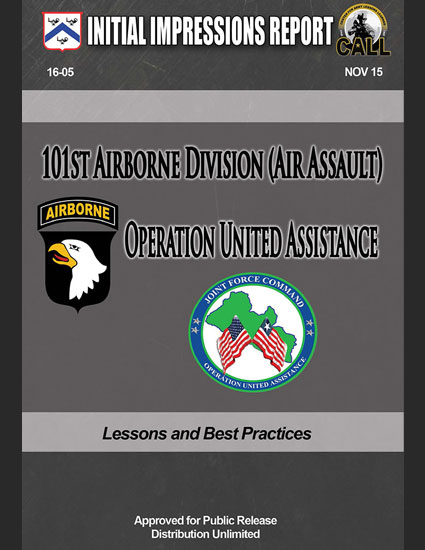 16-05: 101st Airborne Division Operation United Assistance IIR
16-05: 101st Airborne Division Operation United Assistance IIR
This report provides a summary of insights, lessons, and best practices collected from the Commander and staff of the 101st Air Assault Division and the staff of the 101st Sustainment Brigade during the Umbrella Week collection following their return from Operation United Assistance (OUA). The division transitioned to JFC-OUA and led a five-month deployment to Liberia in support of the U.S. Agency for International Development-led mission to fight the spread of the Ebola virus in western Africa.
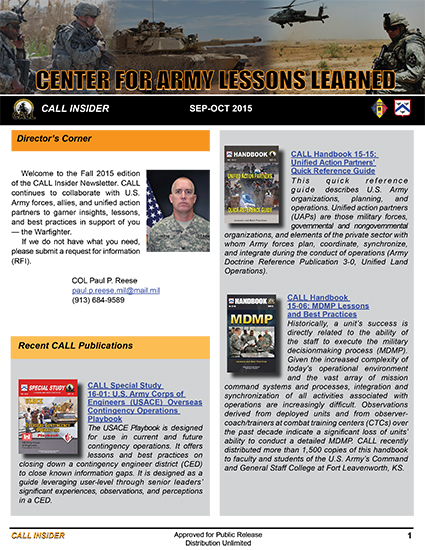 CALL Insider Newsletter Sep - Oct 2015
CALL Insider Newsletter Sep - Oct 2015
Welcome to the Fall 2015 edition of the CALL Insider Newsletter. CALL continues to collaborate with U.S. Army forces, allies, and unified action partners to garner insights, lessons, and best practices in support of you the Warfighter.
The new logo reflects CALL’s 30 years of service in support of the warfighter. CALL
was established on 01 AUG 1985 by the 30th Chief of Staff of the Army, GEN John
A. Wickham Jr., in recognition of the need to collect lessons from training and combat
operations and to share them across the Army.
In the beginning years of our existence, CALL primarily collected and produced analog
(paper) products related to home station training and unit rotations featuring force-on-force
engagements at the maneuver Combat Training Centers. It was not long thereafter that
we proved our mettle in combat operations, as CALL supported Operation Just Cause in
1989 and Operations Desert Shield and Desert Storm in the early 1990s. As technology evolved, so did CALL.
In the early portion of the 2000 decade, CALL established public, NIPR, and SIPR websites, posting digital
products, while continuing to push paper products to the field. We have continued to identify, collect, analyze,
disseminate, and archive lessons and best practices from Operations Iraqi Freedom and Enduring Freedom in
the past decade-plus and for numerous other operations, including peacekeeping efforts in Bosnia-Herzegovina
and humanitarian assistance at home (i.e., Hurricane Katrina) and around the globe (i.e., Operation United
Assistance to combat the Ebola virus).
Many things have changed in the past three decades, but one item has remained constant: It is this organization’s
dedication to support troops, leaders, and units to help maintain global situational awareness in order
to share knowledge and facilitate the Army’s and unified action partners’ adaptation to win wars — now, Force
2025, and beyond.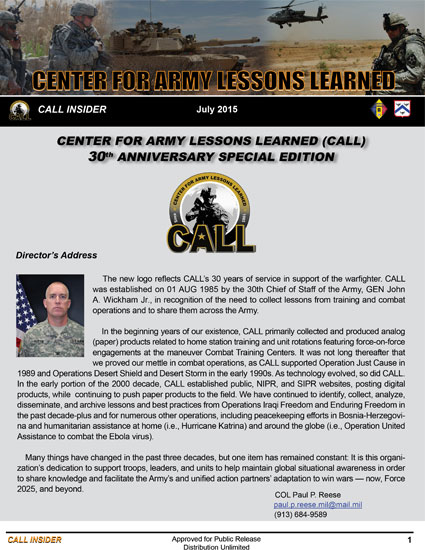 CALL Insider 30th Anniversary Special Edition Newsletter
CALL Insider 30th Anniversary Special Edition Newsletter
I am proud to present Military Review’s first issue published as a member of the Army Press! Our prestigious journal has finally joined ranks with the Combat Studies Institute to form an enhanced organization that will help aspiring authors publish their articles, books, and monographs. The Army Press website is still a work in progress, but we anticipate it coming online soon to provide us with an additional publication and discussion forum. And, we are not stopping there. We look forward to adding the NCO Journal to the Army Press family in 2016. This year’s General William E. DePuy Combined Arms Center Writing Competition was a tremendous success; the quality and quantity of the submissions far exceeded that of previous years, and picking the winner proved very challenging for the selection committee. Thanks to all the authors who contributed. After an exhaustive review of the thirty-two contest submissions, I’m pleased to publically congratulate Lt. Col. Erik Claessen of the Belgian Army for winning the 2015 DePuy competition. His article, “The Urban Individual: Unassailable Source of Power in Twenty-First Century Armed Conflicts,” is featured in this month’s edition. It adds significantly to the growing body of work regarding megaurban conflict and the human dimension. This edition of Military Review also provides articles on a wide variety of other topics. Three authors, Col. Donald Shaw, Thomas Terry, and Milad Minooie, contribute valuable insights on effective communication strategies for Army leaders; historian John McGrath uses World War I’s First Battle of the Marne as a vehicle for an analysis of mission command; and Air Force Lt. Col. Jason Earley discusses how changes in the Army will affect the Air Force. Two junior officers also weigh in with recommendations for changes to Army structure and doctrine. Capt. Vincent Wiggins Jr. advocates changes to how the Army defends against air and missile threats, and 1st Lt. Matthew McGoffin discusses ideas for future adaptation of the cavalry. Military Review English November-December 2015 Edition
Military Review English November-December 2015 Edition
On 01 AUG 2015, CALL celebrated its 30th anniversary of providing lessons and best practices to the U.S. Army and our unified action partners.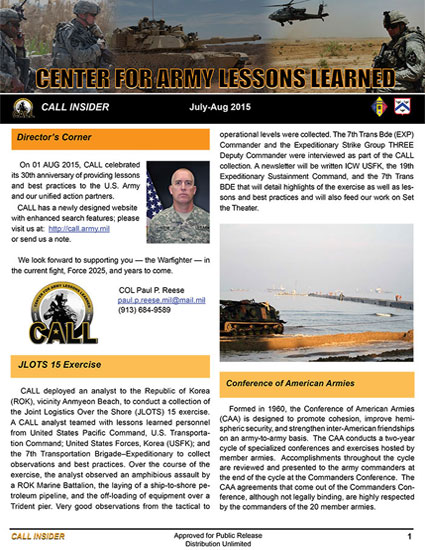 CALL Insider Newsletter July-Aug 2015
CALL Insider Newsletter July-Aug 2015
The United States Corps of Engineers (USACE) Overseas Contingency Operations Playbook provides lessons learned from more than 10 years serving in Iraq and Afghanistan. The playbook's purpose is to capture leaders' significant experiences, observations, issues and perceptions; to share and institutionalize these insights within USACE, the Engineer Regiment, and the Department of the Army to provide a tool for operating effectively in future contingency operations.
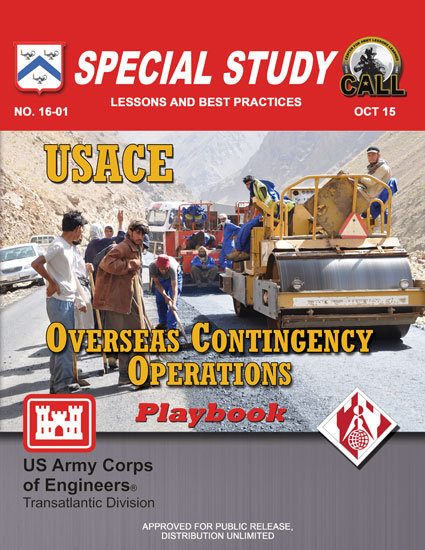 16-01 USACE Overseas Contingency Operations Playbook
16-01 USACE Overseas Contingency Operations Playbook
Talent Management Concept of Operations for Force 2025 and Beyond
We must optimize the human performance of every Soldier and Civilian in the Army Total Force and build cohesive teams of trusted professionals who thrive in ambiguity and chaos. To fulfill this mandate, we must also optimize talent management through work force planning and the acquisition, employment, development, and retention of Army Professionals. As we build better teams comprised of the right individuals, we improve the Army. The principles and functions described in this concept of operations are not intended to address symptoms or second-order problems. Instead, they are designed to support a holistic transformation by establishing the foundation required to implement and sustain the policies and practices that will optimize talent management. This includes building an Integrated Talent Management Enterprise with a single leader, or executive integrator, at the flag officer level to ensure unity of effort. The Army requires a comprehensive Talent Management Strategy for Force 2025 and Beyond. This concept of operations will inform the development of that strategy.
Humanitarian assistance and disaster relief operations are not new to the Army and the Department of Defense (DOD). We gained experience from Hurricane Katrina in 2005 and the 2010 Haiti earthquake. In the response to the Ebola outbreak in West Africa, President Barack Obama announced Operation United Assistance in September 2014, allowing the military to support the United States Agency for International Development. This was the largest role the military had assumed in combating the spread of a disease or virus. The fight against Ebola was on.
The DOD made critical contributions to the fight against the Ebola virus disease outbreak in West Africa. Chief among these was bringing expertise in mission command, logistics, and engineering to assist in quickly getting health workers and medical supplies into West Africa. This Center for Army Lessons Learned bulletin is the result of many interviews and data collection activities with the U.S. Army Africa (USARAF) staff. It is not meant to be totally comprehensive, but rather to serve as a quick and easy-to-read guide for follow-on units focusing on selected key areas.
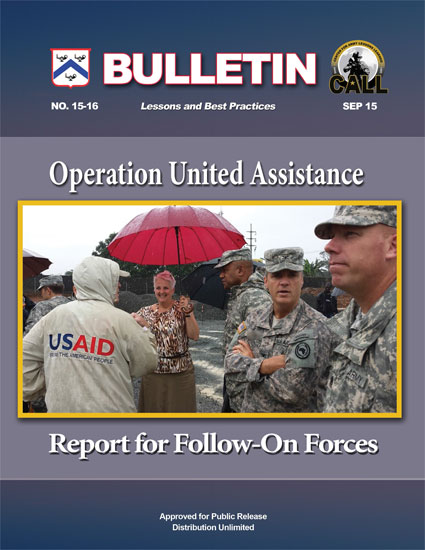 15-16 Operation United Assistance Report for Follow-On Forces
15-16 Operation United Assistance Report for Follow-On Forces
This quick reference guide describes U.S. Army organizations, planning, and operations. Unified action partners (UAPs) are those military forces, of the private sector with whom U.S. Army forces plan, coordinate, synchronize, and integrate during the conduct of operations (Army Doctrine Reference Publication 3-0, Unified Land Operations).
UAPs include joint forces (activities in which elements of two or more U.S. military departments participate), multinational forces, and U.S Government (USG) agencies and departments. The Iraq and Afghanistan wars highlight the necessity for collaboration,
cooperation, and synchronization among USG, NGOs, and private sector agencies to focus the elements of national power in achieving national strategic objectives. Our experience in these conflicts accentuates the importance of foreign governments, agencies, and militaries participating, in concert with the United States, to achieve common objectives. Meeting the challenges of complex environments, infused with fragile or failing nation states, non-state actors, pandemics, natural disasters, and limited resources, requires the concerted effort of all instruments of U.S. national power plus foreign governmental agencies, military forces, and civilian organizations.
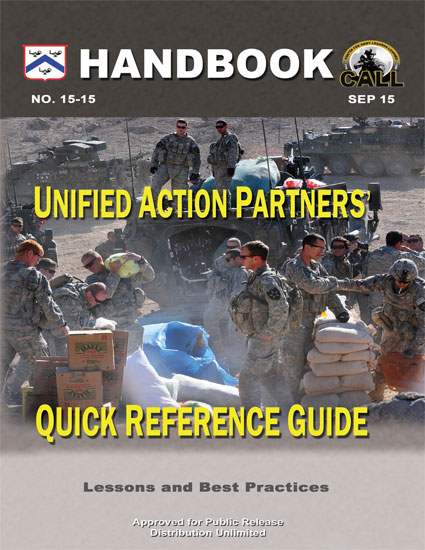 15-15 Unified Action Partners' Quick Reference Guide
15-15 Unified Action Partners' Quick Reference Guide
As we ease into the fall months, the staff at Military Review is in the process of transitioning to the Army Press, a joint effort between Military Review and the Combat Studies Institute. The intent of this enhanced organization is to effectively identify, encourage, and support authors who want their articles, books, and monographs published in Department of Defense and Army center of excellence publications, such as Military Review, or other military-related publications, blogs, or websites.
Many talented individuals worked long and hard to turn the Army Press concept into reality. I am confident this organization will be a highly valued asset to the recently announced Army University and a great resource for the entire Army. Look for more information on the Army Press in future issues of this journal. In this edition of Military Review, Maj. Gen. Wayne Grigsby and a team of subject matter experts discuss how using good judgement in the application of Army mission command principles provided unique solutions to the unique problems faced by Combined Joint Task Force—Horn of Africa while conducting theater security cooperation missions. Also in this issue, Maj. Theresa Ford demonstrates how applying the Army’s seventh warfighting function—engagement—will help soldiers work more effectively with nations, regional partners, and indigenous populations. She discusses the need for soldiers to understand religion’s importance and to develop skills for building relationships in communities where religion plays a central role. Ford feels religion remains one of the most important elements of the human domain in Afghanistan, and she relates some fascinating stories of how she successfully used what she calls religious engagement to build relationships with key individuals in that country. Another article, authored by one of our own editors, Desirae Gieseman, is a must read for all Army writers. In it, she explains why Army writing is effective when it is functional. She discusses the strengths and weaknesses of the traditional Army writing standard and describes the critical role of purpose for Army writers and for Army readers. She also introduces processes writers can use to write effectively—with a focus on planning—and proposes a practical approach for the Army to achieve accountability for writing standards. Military Review English September-October 2015 Edition
Military Review English September-October 2015 Edition
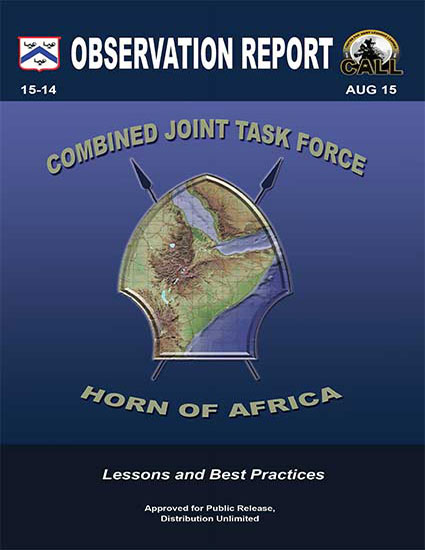 15-14 Combined Joint Task Force Horn of Africa (CJTF-HOA) Observation Report
15-14 Combined Joint Task Force Horn of Africa (CJTF-HOA) Observation Report
At the request of the Commander, CJTF Horn of Africa (HOA), the Center for Army Lessons Learned (CALL) planned and conducted a collection with key members of the CJTF staff from 31 Oct 14 to 7 Nov 14. This report focuses on the following areas and reflects the lessons and best practices in the CJTF at the time of collection: Mission Command, CJTF Sourcing and Manning, CJTF-HOA Staff Reorganization, Fusion Action Cells (FAC), Information Sharing with Partner Nations, Foreign Liaison Officers, Relationships and Enabling United Action Partners, SOF and GPF Interdependence, Staff Judge Advocate, Regionally Aligned Force (RAF), Counter IED, East African Response Force (EARF), and Civil Affairs

